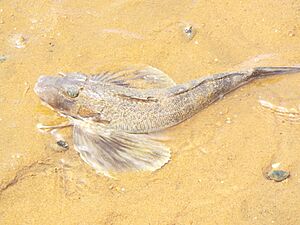Northern sea robin facts for kids
Quick facts for kids Northern sea robin |
|
|---|---|
 |
|
| Conservation status | |
| Scientific classification | |
| Synonyms | |
|
The northern sea robin (scientific name: Prionotus carolinus) is a cool type of ray-finned fish. It belongs to a group of fish called sea robins. You can find this interesting fish swimming in the western part of the Atlantic Ocean.
Contents
About the Northern Sea Robin
What's in a Name?
Scientists give every animal a special name. The northern sea robin's scientific name is Prionotus carolinus. A famous Swedish scientist named Carl Linnaeus first described this fish in 1771. He named it after "Carolina," which was where he found it.
What Does It Look Like?
The northern sea robin has a unique look! It has a wide, spiny head and a body that gets thinner towards its tail. Its eyes are a pretty blue color. One of its most noticeable features is its large, wing-like pectoral fins.
Its back can be reddish or grayish, and its chin is black. The belly is usually pale. Its fins are reddish-brown with darker edges, becoming grayish-white near their bases.
Special Fins for Walking
Guess what? The northern sea robin has a super cool trick! The three lower rays of its pelvic fins are like special "feelers." It uses these to "walk" along the ocean floor. This helps it stir up sand and mud to find hidden food. Northern sea robins usually grow to be about 17 inches (43 cm) long.
Where Do They Live?
You can find the northern sea robin in shallow parts of the western Atlantic Ocean. Their home stretches from Nova Scotia in Canada, all along the Atlantic coast of the United States, and into the Gulf of Mexico. They live as far south as the upper Florida Keys.
They like to hang out in places like estuaries (where rivers meet the sea) and near the edge of the continental shelf. They especially love sandy bottoms. This is because they use their special "walking" fins to kick up sand and find tasty snacks hiding there.
What Do They Eat?
The northern sea robin isn't a picky eater! It enjoys a wide variety of small ocean creatures. Some of its favorite foods include:
- Shrimp
- Crabs
- Amphipods (tiny crustacean animals)
- Squid
- Clams and other bivalve mollusks
- Segmented worms
They are known to bite almost any bait, which shows they are not very choosy about their meals.
How Are They Used?
Fishing for Fun
Many people enjoy catching northern sea robins for sport. They are known to put up a good fight when hooked, which makes fishing for them exciting!
Eating Them
Even though their spines can make them a bit tricky to clean, northern sea robins have tasty meat. Some people say their flesh tastes similar to Kingcroaker or whiting. You can cook them by broiling or baking them.
Other Uses
Sometimes, northern sea robins are used to make fish meal, pet food, or even fertilizer. Fishermen also use them as bait in lobster pots and on handlines to catch flatfish. Believe it or not, their eggs have even been used as a substitute for caviar!


